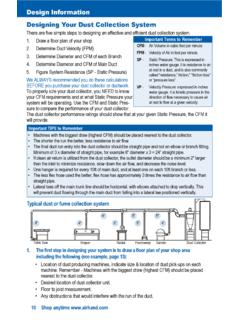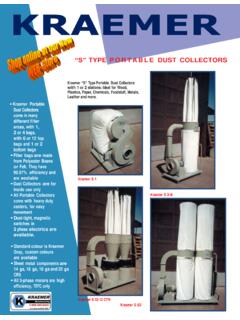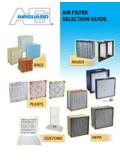Transcription of WOOD DUST - Fine Wood Work Association (WA) Inc.
1 fine Wood work Association Western Australia Presentation by Bob Loss March 2013 FWWA meeting 1 WOOD dust fine Wood work Association Western Australia Introduction Below is a picture of what we commonly think of as wood dust . We can see and feel it and it is nuisance in our workshops in that it clogs machinery and makes floors slippery. It also makes us sneeze and somewhere along the way you may have heard that it is not that good for you. In a handful of sawdust most of the particles of sawdust are so small as to be invisible. These invisible particles can be magnified up with a microscope and guess what?
2 They look just like big bits of sawdust (See photo on right). One big difference between big and small dust particles is their ability to enter our bodies. But before discussing this, just how small are we talking about? 2 WOOD dust fine Wood work Association Western Australia Wood dust Particle Sizes The picture below shows the sizes involved. As a point of reference I will use a human hair which is typically 70 microns ( mm) in diameter. Wood dust covers the range from millimetres down to less than microns. The labels PM in the diagram refer to Particulate Matter, so PM10 means particles smaller than 10 microns.
3 3 WOOD dust The unassisted human eye cannot see particles smaller than about 10 microns, and for people over 50 years of age even larger. While most of the weight of wood in sawdust will be in the visible particles, most of the particles will be to small to see; and a potential health problem is that it is the smaller particles that are most likely to cause health problems. The health problems caused by small wood dust particles are almost certainly related to the degree of penetration possible by the smaller particles. The diagram on the next page shows the sizes of particles typically lodged in airways.
4 Particles larger than about 10 microns do not remain suspended in air for long so it is the 10 to less than 1 micron sizes that can enter airways. Here they lodge and release irritants which can eventually cause serious health problems, the most common being cancers in the upper respiratory tract, but stomach cancer rates are also elevated amongst wood workers. fine Wood work Association Western Australia Wood dust Particle Sizes (cont d) Wood dust has been on the USA National Institutes of Health list of 200 recognised materials and chemicals likely to cause cancer, since 2002.
5 It would not be on this list if it did not concern health authorities. Particles smaller than about micron are not considered a problem as they stay suspended in air and are easily breathed out again. 4 WOOD dust fine Wood work Association Western Australia 5 The 1 ppm for hardwood standard is not very useful because it does not say what size of particles this is for. More recent European standards now specify sizes. In terms of the wider community European standards specify a standard of ppm for PM10 airborne dust . The next question is How much dust is too much ?
6 In terms of Australian OHS standards, the most common standard (and considered by some health authorities as too high) for wood dust is 5 milligrams of dust in one cubic metre of air (5 ppm) for softwoods and 1 ppm for hardwood; Wood dust Particle Sizes (cont d) but what does this mean in practice? In the picture a soft drink bottle cap contains a pinch of fine hardwood dust that weighs This much dust suspended in air is enough to contaminate four sheds, each 6 x 4 m, to above the 1 ppm OHS standard. As Bill Pentz (at : Cyclone and dust Collection Research) says this is less than the amount of dust a wood worker might shake off their shirt at the end of a working day.
7 fine Wood work Association Western Australia Wood dust Exposure by Occupation Next we will look at what woodworking occupations generate dust . The table shows the industry or job group and typical exposure in mg/m3, which is the same as ppm. Construction carpenters are exposed to the widest range of dust , presumably because they work across a wide range of locations, from the wide outdoors to inside small walk-in cupboards. The next most exposed groups are turners, whose minimum exposures are above the OHS standard, but most groups are at risk especially given that the 1ppm OHS standard is considered too high.
8 6 WOOD dust Wood dust Particle Sizes by Activity The diagram on the next page presents a chart showing the amounts of dust produced by various wood working activities on different timbers. Fortunately most of the weight of the particles is in the heavier, larger, less dangerous particles. Perhaps not unexpectedly the one activity that stands out as producing small particles is sanding. N is the number of wood working sites surveyed. fine Wood work Association Western Australia Wood dust Particle Sizes by Activity (cont d) 7 WOOD dust While diagrams like that above may seem reassuring, unfortunately tiny particles weigh very little so even a few percent of the total weight can still represent millions of particles per cubic metre.
9 The diagram on the next page charts the numbers of wood dust particles suspended in air after sweeping a wood working shed, and what happens to the numbers over time after sweeping. The amount of sawdust on the floor was low in that the floor underneath could still be clearly seen. The various coloured lines refer to the different particle size ranges, eg. the refers to particles in the to micron particle size range. The left hand vertical axis shows the number of particles and the X-axis shows time in minutes. The line labeled Conc shows the concentration of wood dust in the air in ppm and refers to the right hand vertical axis.
10 fine Wood work Association Western Australia There is a lot of information on the chart. Firstly it shows the very large number of smaller particles compared to the larger particles present in the saw dust . Next the Conc line shows that in this case just sweeping the floor increased the concentration of wood dust in the air to about 12 time the OHS standard, and it then takes about 30 min to get to below the 1 ppm OHS standard. The larger particles (>5 microns) drop off a lot more quickly (about twice as fast) than the smaller ones. This data demonstrates why dust collectors should be left running for some time after the last dust making activity as wood dust invariably escapes from all dust collection.






